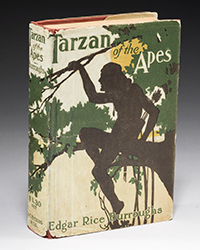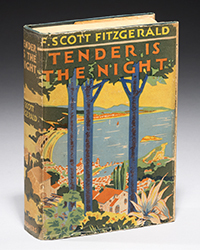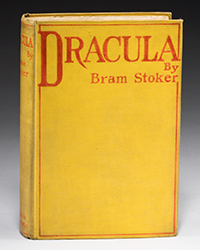Recently released data from book and publisher organizations in the U.S. and Canada reveal some surprising results. The inevitable transition from print and paper to electronic impulses and e-readers may not be quite so inevitable after all. The rapid transition of a few years ago seems to have stalled. There may even be some slight backtracking, though essentially it appears the shift has flat-lined.
Normally, considerations involving new books are not topics for a website devoted to rare and antiquarian books. However, to those concerned about where the next generation of collectors will arise, sales of new books do matter. Many collectors collect that which they know, and especially that which they knew in their youth. Those raised reading digital imprints on the screens of Kindles and iPhones are less than ideal prospects for book collecting later. If you didn't like printed books when you were young, why would you want to collect them when you are older?
According to figures recently released by the Association of American Publishers, eBook sales for the first half of 2015, compared to the same period a year earlier, were down by 10.3%. We would caution against reading too much into this number. It doesn't mean eBooks are about to disappear. There has been some up and down over the past few years in the category. Last year, for whatever reason, there was a huge spike in children's and young adults' books pushing up eBook numbers. Much of that increase was given back this year. There was also a dip of 11% in the sale of hardcover books this year. However, what we do notice is that, after several years of rapid growth, the sales of eBooks essentially have become flat. The same is true of hardcover books.
On the other hand, sales grew substantially in the category of mass market and paperback books. Paperback sales were up by 12.5% over last year. This number was particularly notable as sales of paperbacks had been steadily declining for years. This was a clear reversal of direction. What we may be seeing here is something of a return to the paper format by those seeking a book convenient for reading. Despite the advent of electronic books, many people have continued to prefer books that can be handled, their pages opened. What we have not seen before is a sign that perhaps some who moved to an electronic format in the past, or are new/younger readers, also may prefer reading paper books.
Results from Canada were similar, although spikes were more flattened out in that market. Comparing 2015 to 2013, Booknet Canada (a non-profit organization designed to help the book trade) found a very slight decrease in eBooks' market share. It went from a hair over 17% of book sales to a hair under. Paperbacks saw a similar slight decline, while it was hardcovers that saw a small increase in market share. The Canadian study also looked at library visitors. They found 11% of library visitors in 2015 borrowed an eBook, down from 12% in 2012. The percent of visitors borrowing a printed book remained steady at 74%. Again, it showed the printed format at least holding its own.
Interestingly, while the Canadian study saw an even to slight increase in the percentage of physical books being sold, it still found a large increase in the percentage of them being purchased electronically. It reported online sales have "increased drastically since 2013." The percentage of books purchased online rose from 29% to 45% in just two years. Chain stores, discount stores, and book stores, the three biggest other selling venues, all saw their shares of sales decline.
Recently reported sales figures from two major publishers seem to confirm the softness in eBook sales. HarperCollins reported a decline in digital sales in the third quarter of 2015 vs. the same quarter last year of 11.8%. The figure for Simon & Schuster was 10.7%. Digital sales include audio books, but their sales appear to be holding up well. The CEO of Simon & Schuster pointed out that there are other factors present, such as a change in the product offered year to year. They aren't too concerned about the decline, at least not yet.
Again, it is too early to draw any drastic conclusions. Trends may have stalled, rather than been broken. Still, for those who love books, and by this we mean bound paper, physical objects, it is a gratifying development. Conventional wisdom about the death of books may be greatly exaggerated. Another generation may yet choose to fill its bookshelves with books, rather than broken old Kindles, Nooks, and iPhones.




















![<b>Sotheby’s, Dec. 11:</b> Darwin and Wallace. On the Tendency of Species to form Varieties..., [in:] <i>Journal of the Proceedings of the Linnean Society,</i> Vol. III, No. 9., 1858, Darwin announces the theory of natural selection. £100,000 to £150,000. <b>Sotheby’s, Dec. 11:</b> Darwin and Wallace. On the Tendency of Species to form Varieties..., [in:] <i>Journal of the Proceedings of the Linnean Society,</i> Vol. III, No. 9., 1858, Darwin announces the theory of natural selection. £100,000 to £150,000.](https://ae-files.s3.amazonaws.com/AdvertisementPhotos/00d5fd41-2542-4a80-b119-4886d4b9925f.png)






![<b>Heritage, Dec. 15:</b> John Donne. <i>Poems, By J. D. With Elegies on the Author's Death.</i> London: M[iles]. F[lesher]. for John Marriot, 1633. <b>Heritage, Dec. 15:</b> John Donne. <i>Poems, By J. D. With Elegies on the Author's Death.</i> London: M[iles]. F[lesher]. for John Marriot, 1633.](https://ae-files.s3.amazonaws.com/AdvertisementPhotos/8caddaea-4c1f-47a7-9455-62f53af36e3f.jpg)



